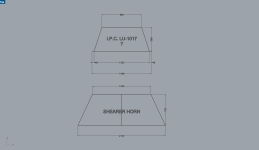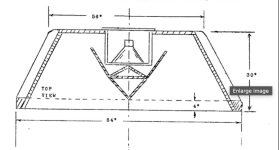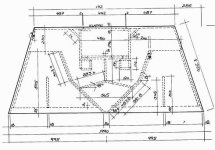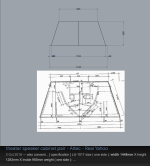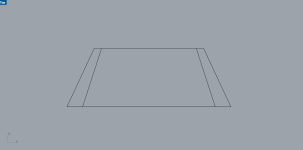Altec Cabinet Plans some not all!
Rob 🙂
https://www.lansingheritage.org/html/altec/plans/altec-plans.htm
Rob 🙂
https://www.lansingheritage.org/html/altec/plans/altec-plans.htm
Don't see why it should be much, if any, real difference than 515B/later 288 drivers, so very benign IME.How’s the impedance curve on the 515RWB and the 288 Hollywood in general?—is it like a jigsaw? ( one of the most notorious, the Quad ESL57 )
Qts is .38 so relatively decent magnet strength overall.
Fs seems high around 72 Hz
For ported/reflex usually tuning is slightly above or below Fs
I wouldn't want such a high tuned port.
68 to
With conventional " Alignments " the data doesn't translate to well.
I dont like " making up" alignments like many seem to do.
But my attempt is just adding " a little bass" to whatever it shows in a standard .707 Qtc sealed box
and using a port tuning not to high to the moon.
Ends up being somewhat generic for some modern live sound drivers ironically
3 cubic feet / 85 liters tuned 50 Hz.
Seems reasonably, a port tuned any higher would be obnoxious.
Yellow / sealed .707 Qtc Grey / ported
All I got
Not sure if it is the paper edge, or phenolic spider, or measurement of a fresh re cone making Fs high.
Maybe after few hours of playtime, or even cheat a little and measure it mounted to a open baffle to measure free air resonance.
Another site mentioned messing with the compliance using a cloth edge surround instead to lower Fs.

Fs seems high around 72 Hz
For ported/reflex usually tuning is slightly above or below Fs
I wouldn't want such a high tuned port.
68 to
With conventional " Alignments " the data doesn't translate to well.
I dont like " making up" alignments like many seem to do.
But my attempt is just adding " a little bass" to whatever it shows in a standard .707 Qtc sealed box
and using a port tuning not to high to the moon.
Ends up being somewhat generic for some modern live sound drivers ironically
3 cubic feet / 85 liters tuned 50 Hz.
Seems reasonably, a port tuned any higher would be obnoxious.
Yellow / sealed .707 Qtc Grey / ported
All I got
Not sure if it is the paper edge, or phenolic spider, or measurement of a fresh re cone making Fs high.
Maybe after few hours of playtime, or even cheat a little and measure it mounted to a open baffle to measure free air resonance.
Another site mentioned messing with the compliance using a cloth edge surround instead to lower Fs.
Last edited:
Thanks!
Greatly appreciated. I will definitely play the 515, mounted in a OB, at low volumes, then redo measuremts.
The 515RWB can play music, connected directly to an amp, mounted in an OB, at low volumes? Any precautions?
While I’m at it:
The 288 Hollywood got, as far as I understand, the original diaphragm installed, no dent, etc….correct vintage wires, never de-attached.
About the 288; how will I, in the simplest way, make it robust ( enough ) , to handle adjustments either done with a DSP or a variable crossover box; while fine tuning the setup?
There has to be something I can to make it safe, without the risk of damaging the diaphragm?
Installing a capacitor with correct valuees, after the variable crossover, the correct way of make it more capable to handle mistakes?
Greatly appreciated. I will definitely play the 515, mounted in a OB, at low volumes, then redo measuremts.
The 515RWB can play music, connected directly to an amp, mounted in an OB, at low volumes? Any precautions?
While I’m at it:
The 288 Hollywood got, as far as I understand, the original diaphragm installed, no dent, etc….correct vintage wires, never de-attached.
About the 288; how will I, in the simplest way, make it robust ( enough ) , to handle adjustments either done with a DSP or a variable crossover box; while fine tuning the setup?
There has to be something I can to make it safe, without the risk of damaging the diaphragm?
Installing a capacitor with correct valuees, after the variable crossover, the correct way of make it more capable to handle mistakes?
Can a lower mass on the replacement cone causing the high Fs, if this a plausible situation:
1. How do I find a reference value on the RWB cone?
GM has already pointed out that the RWB cone is probably the same cone used in earlier models, with field coils? Both has no standard TS parameters…
2. How precise should this reference be? —I do still have the original cone, but it is is cut down, see attached photo. Is this a good enough value?
3. been told that; by adding mass / coating to the replacement cone, it can, maybe, interfere with the mid range frequency produced from the 515RWB, one solution is to use a low-pass filer around 500hz..the dividing is already low, but should it roll off naturally in the top?
4. What should I use coat the cone with for adding mass?
1. How do I find a reference value on the RWB cone?
GM has already pointed out that the RWB cone is probably the same cone used in earlier models, with field coils? Both has no standard TS parameters…
2. How precise should this reference be? —I do still have the original cone, but it is is cut down, see attached photo. Is this a good enough value?
3. been told that; by adding mass / coating to the replacement cone, it can, maybe, interfere with the mid range frequency produced from the 515RWB, one solution is to use a low-pass filer around 500hz..the dividing is already low, but should it roll off naturally in the top?
4. What should I use coat the cone with for adding mass?
Attachments
I’m stuck. I need a referanse weight of one 515RWB, if not the extra mass I will coate my 515RWb will be too imprecise.
I will need a reference on a complete 515RWB to fingers out how much mass is missing.
It will probably never be tuned, as the original paper cone was intended; for replicating voices ( the voice of the theater ); but this is what I have to work with.
my interest for getting these a5 parts not only to play, but to sing is of great interest.
If I could get a referanse weight to work with I can do further research and see how it plays potentially better than it does today, then I can further update DATS measurements.
I will need a reference on a complete 515RWB to fingers out how much mass is missing.
It will probably never be tuned, as the original paper cone was intended; for replicating voices ( the voice of the theater ); but this is what I have to work with.
my interest for getting these a5 parts not only to play, but to sing is of great interest.
If I could get a referanse weight to work with I can do further research and see how it plays potentially better than it does today, then I can further update DATS measurements.
It looks to me that I.P.C Western Electric LU-1017 cabinet can be a suitable cabinet for the 515a, but there are no plans available?
...to me it looks like there are two, almost, identical cabinet plans for the Shearer horn;
can the measurements assigned to the one of these drawings be wrong?
I have found one, partial, weblink, the advertisement is gone, of the LU-1017 cabinet, containing front ( width ), rear ( width ) , and height, a standard wooden bracing of 48x48mm on each side of the front, adds up; the proportions of the front and rear width looks correct.
See attached images.
The Shearer horn has 80 inches w. front x 60 inches w.rear x 30 inches depth.
The I.P.C LU-1017 has 57 inches w.front x 38 inches w.rear x 23.5 inches depth ?
...to me it looks like there are two, almost, identical cabinet plans for the Shearer horn;
can the measurements assigned to the one of these drawings be wrong?
I have found one, partial, weblink, the advertisement is gone, of the LU-1017 cabinet, containing front ( width ), rear ( width ) , and height, a standard wooden bracing of 48x48mm on each side of the front, adds up; the proportions of the front and rear width looks correct.
See attached images.
The Shearer horn has 80 inches w. front x 60 inches w.rear x 30 inches depth.
The I.P.C LU-1017 has 57 inches w.front x 38 inches w.rear x 23.5 inches depth ?
Attachments
The second drawing is more of a principle draw to give an idea than a plan. A very different design from 3 and 4, which can be used for a build and will reach deeper.
- Home
- Loudspeakers
- Multi-Way
- Altec Lansing H110 (1940s A5) cabinet plans

